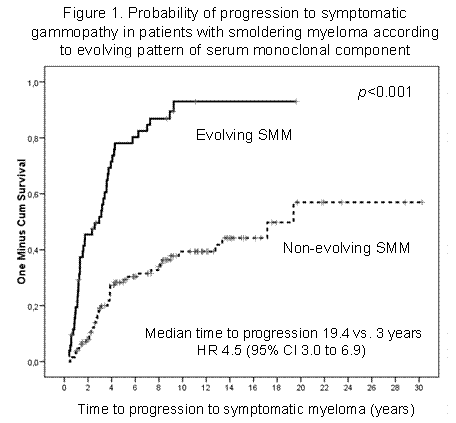Abstract
Introduction: Smoldering multiple myeloma (SMM) is a plasma cell dyscrasia defined by the presence of a monoclonal protein (MP) (≥ 30 g/L in serum or >1g/24-hours in urine) and/or plasma cell bone marrow involvement (BMPC) ≥ 10%, in the absence of symptoms due to the gammopathy. The risk of progression to symptomatic disease in patients with SMM is highly variable. Several biomarkers and prognostic index associated with risk of early progression based on tumoral load (M-protein size and percentage of BMPC), M-protein behaviour (evolving vs. non-evolving) and/or immunological status (heavy chain isotype, isotype suppression of uninvolved immunoglobulins and serum free light-chain (FLC) κ/λ ratio) have been recently identified. The identification of patients at risk for early progression is crucial when considering the current possibility of prompt therapeutic intervention. The aim of this study was to analyze the factors associated with early progression to multiple myeloma (MM) in patients diagnosed with SMM and long follow-up in a single institution.
Methods: Medical records of the 207 patients (76M/131M; median age 65 years, range 33 to 92) diagnosed with SMM (International Myeloma Working Group criteria, 2003) at our institution between January 1973 and December 2012 were systematically reviewed. Progressive increase in the value of MP was defined as "evolving" when at least 10% increase was observed within the first 6 months from diagnosis when MP was ≥ 30 g/L (Rosiñol et al, Br J Haematol. 2003) or progressive increase in MP in each of the annual consecutive measurements during a period of 3 years in patients with an initial MP < 30 g/L (Rosiñol et al, Mayo Clin Proc. 2007). Immunoparesis was defined as any value below normal in not involved immunoglobulins. Bone marrow aspirates obtained at diagnosis were reviewed independently by 2 observers. Plasma cell percentages were estimated from a 500-cell count by each examiner and the mean values were considered.
Results: Sixty-seven patients (33%) accomplished both SMM criteria (MC and BMPCs), while the remaining 140 patients only had one of them. With a follow up of 1,692 years-person, 105 patients had progressed (50.7%) to MM and one case to AL amyloidosis (0.5%). The estimated probability of progression at 2 and 5 years was 19.9% and 44.9% respectively, with a median time to progression (TTP) of 7.3 years (95% CI 3.9 to 10.6).
At the time of progression, clinical manifestations were mainly anemia (52%) and skeletal lytic lesions (40%). The presence of renal insufficiency, extramedullary plasmacytomas or hypercalcemia was only identified in 12 patients (5.8%). The median survival after progression was 5 years (95% CI 3.8 to 6.2).
Evolving type was recognized in 25% of the patients, and was associated with a probability of progression of 45% and 78.1% at 2 and 5 years and was higher than those with stable MP (HR 4.5; 95% CI 3 to 6.9; p<0.001) (Figure 1). Evolving pattern was more frequently associated with IgA isotype (41.2% vs. 23.8%; p=0.02). Negative impact in median TTP of evolving type was significant in patients either with both diagnostic criteria (MP and BMPCs; 1.3 vs. 6.3 years, p<0.001) and in those with only one of them (3.7 vs. not reached; p<0.001).
At the univariate analysis the MP size (< vs. ≥ 30 g/L, median 13.4 vs. 3.1 years, p<0.001), the proportion of BMPCs (< vs. ≥ 20%, 17.2 vs. 2.9 years, p<0.001), the presence or absence of immunoparesis (3.9 vs. 16.9 years, p=0.001) and the evolving pattern (19.4 vs. 3 years, p<0.001) were significantly associated with a higher risk of progression. At the multivariate analysis only the evolving type (HR 4.9, 95% CI 2.8 to 8.7, p<0.001), the proportion of BMPCs (HR 2.5, 95% CI 1.3 to 4.6, p=0.004) and the presence of immunoparesis (HR 1.9, 95% CI 1.03-3.6, p=0.042) retained their statistical significance. Considering these last three variables, a model of risk stratification (Figure 2) was built, ranging from a probability of progression at 2 years of 81.8% for patients with the 3 factors present to only 4% for patients in group 4 (no risk factors).
Conclusion: In this series of patients with SMM with long follow up, evolving pattern, proportion of BMPCs and the presence of immunoparesis can accurately predict accurately the risk of early progression to symptomatic disease. Evolving type should be routinely monitored during the follow up of patients with SMM, since it is the most significant predictor for early progression.
No relevant conflicts of interest to declare.
Author notes
Asterisk with author names denotes non-ASH members.



This feature is available to Subscribers Only
Sign In or Create an Account Close Modal